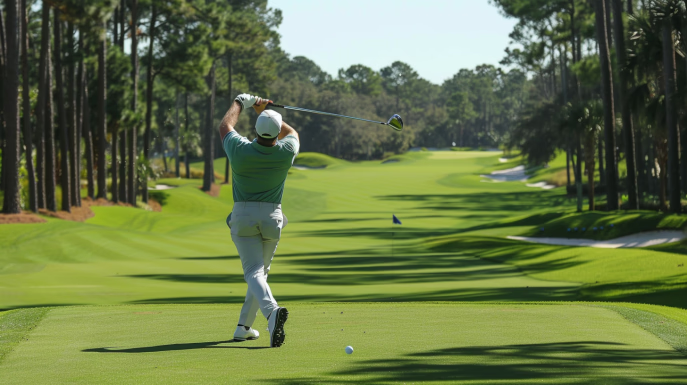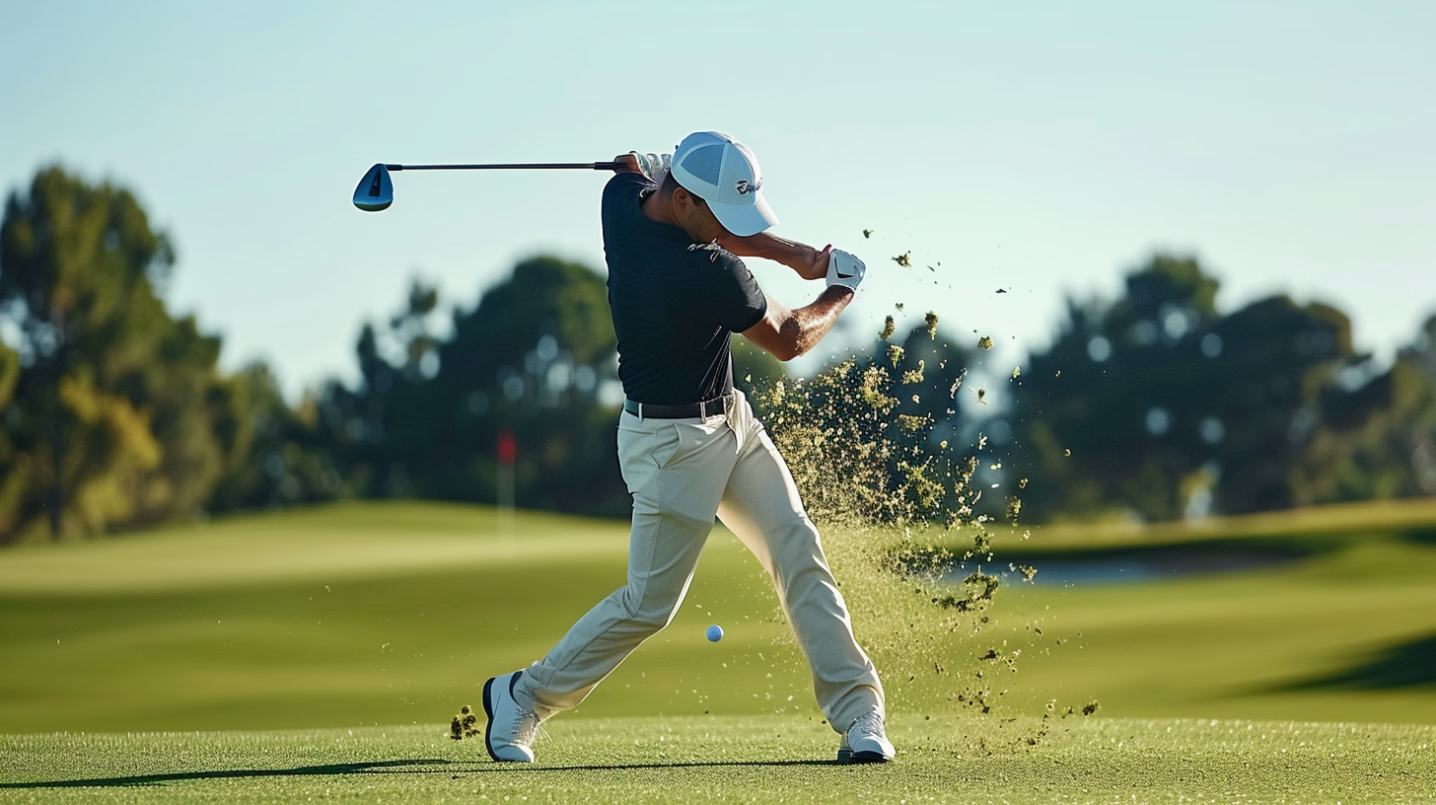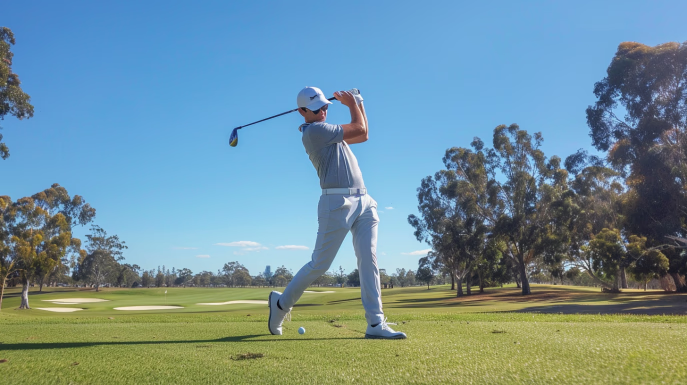Golf Swing Arc: Mastering the Coveted Arcing Swing Path

Source : pinnaclegolfpros copyright
Unlocking the secret to pure, powerful ball-striking is all about mastering the coveted golf swing arc – the arcing swing path that delivers explosive distance and pinpoint accuracy. In this comprehensive guide, you’ll discover the fundamentals, techniques, and tools to refine your swing arc and take your game to new heights.
The golf swing arc refers to the curved path the clubhead travels during the swing, from the backswing through the downswing and impact. Mastering this crucial element of the swing is essential for achieving consistent, powerful ball-striking, as well as the ability to shape shots and control ball trajectory. Whether you’re an amateur golfer looking to improve your game or a seasoned pro seeking to fine-tune your mechanics, understanding the principles of the swing arc can unlock a new level of performance on the course.
Key Takeaways
- The golf swing arc is the curved path the clubhead traces during the swing, from the backswing to impact.
- Mastering the swing arc is crucial for consistent, powerful ball-striking and shot-shaping abilities.
- Understanding the fundamentals of swing plane, centrifugal force, balance, and rotation dynamics is key to refining your swing arc.
- Proper grip, stance, and swing tempo are essential for creating an optimal backswing arc.
- Mastering the downswing arc is critical for generating explosive power and precision.
Understanding the Fundamentals of the Golf Swing Arc

To master the golf swing arc, it’s essential to understand the fundamentals that govern this crucial element of the golf swing. The swing arc refers to the curved path the clubhead travels during the swing, from the backswing through the downswing and impact. Exploring the intricacies of the swing arc basics, the role of swing plane, and the impact of centrifugal force will provide a solid foundation for refining your golf swing.
Swing Arc Basics: Inside-Out vs. Outside-In Paths
The swing arc can be characterized as either an inside-out or outside-in path. An inside-out swing arc describes a clubhead path that moves from the inside of the target line during the backswing and then swings outward towards the target line during the downswing. Conversely, an outside-in swing arc features a clubhead path that travels from the outside of the target line in the backswing, transitioning to an inside-out path during the downswing. Understanding the differences between these two swing arc types is crucial for developing consistent, repeatable ball-striking.
The Role of Swing Plane in Maintaining a Consistent Arc
The swing plane, the imaginary angle at which the club travels through the swing, plays a vital role in maintaining a consistent swing arc. By keeping the clubhead moving along the proper swing plane, golfers can ensure a smooth, arcing path from the backswing to the follow-through. Mastering the swing plane will help golfers achieve greater consistency, reduce swing flaws, and produce more accurate, powerful shots.
Centrifugal Force and Its Impact on the Arcing Path

Centrifugal force, the outward force experienced during the swing, has a significant influence on the golf swing arc. As the clubhead accelerates through the downswing, the centrifugal force acting on it creates an outward pull, contributing to the arcing path of the clubhead. Understanding the dynamics of centrifugal force and how it affects balance, rotation, and the overall swing arc is essential for developing a powerful, consistent golf swing.
Achieving Balance and Rotation Dynamics
Proper balance and efficient rotation dynamics are essential for achieving an optimal golf swing arc. The relationship between shoulder turn and hip rotation is the key to unlocking power and consistency, as well as a fluid arcing path.
Shoulder Turn: The Catalyst for an Efficient Swing Arc
The shoulder turn is the foundational element that sets the stage for an efficient golf swing arc. By initiating a full and controlled shoulder turn during the backswing, golfers can create the necessary rotation dynamics to generate ample power and weight transfer through the downswing. This shoulder rotation is the catalyst that propels the clubhead along the desired arcing path, ensuring a consistent and repeatable swing.
Hip Rotation: Unlocking Power and Consistency
Complementing the shoulder turn is the crucial role of hip rotation in achieving an optimal swing arc. As the golfer transitions from the backswing to the downswing, the proper sequencing and timing of the hips are instrumental in maintaining balance and transferring power through impact. By synchronizing the hip and shoulder rotation, golfers can unlock the true potential of their swing arc, delivering exceptional consistency and ball-striking prowess.
Mastering the Backswing Arc
The foundation of the golf swing arc is built during the backswing, where the clubhead traces an arcing path that sets the stage for a powerful, consistent downswing. Mastering the backswing arc is crucial for achieving the desired ball flight and shot-shaping capabilities.
Proper Grip and Stance for an Optimal Backswing
Establishing the proper grip and stance is the first step towards mastering the backswing arc. A well-balanced and aligned setup can help you initiate a fluid, consistent backswing that sets the tone for the rest of your swing mechanics.
Swing Tempo: The Key to a Fluid Backswing Arc

The swing tempo plays a crucial role in maintaining a smooth, arcing path throughout the backswing. By developing a rhythmic, unhurried tempo, golfers can ensure a fluid backswing that builds the necessary momentum for a powerful downswing and impact.
| Backswing Arc Factors | Importance | Tips for Improvement |
|---|---|---|
| Grip and Stance | Fundamental for a consistent backswing | Engage in regular grip and stance drills to ingrain proper positioning |
| Swing Tempo | Critical for a smooth, arcing backswing | Practice slow, rhythmic swings to develop a natural, fluid swing mechanics |
| Backswing Arc | Lays the foundation for a powerful, controlled downswing | Utilize visual aids and feedback to monitor and refine the backswing arc |
The Downswing: Unleashing Power with an Arcing Path
The true power and precision of the golf swing arc are unleashed during the downswing, as the clubhead traces an arcing path from the top of the backswing to impact. Mastering the dynamics of the downswing arc is essential for generating explosive distance and shaping shots with pinpoint accuracy.
Weight Transfer and the Downswing Arc

Effective weight transfer during the downswing is a critical component of an optimal swing arc. As the golfer transitions from the backswing to the downswing, the proper shifting of weight from the rear foot to the front foot helps create the necessary power and momentum to propel the clubhead along an arcing path. This weight transfer, coupled with a smooth, rhythmic swing mechanics, enables the golfer to consistently deliver the clubface to the ball with precision and control.
Clubface Alignment and Its Impact on Ball Trajectory
The alignment of the clubface at the point of impact is a key factor in determining the ball trajectory. A properly aligned clubface, in sync with the arcing downswing path, allows the golfer to launch the ball on the desired trajectory, whether it’s a high-flying shot, a penetrating draw, or a sweeping fade. By mastering the relationship between clubface alignment and the swing arc, golfers can effectively shape their shots and navigate various course conditions with confidence.
The Impact Zone: Where the Golf Swing Arc Meets the Ball
At the very heart of the golf swing lies the impact zone – the critical moment when the clubhead makes contact with the ball. It is here that the golf swing arc truly manifests its full potential, as the clubhead’s path, the clubface alignment, and the subsequent ball trajectory converge to deliver the desired shot.
The swing mechanics at play in the impact zone are the culmination of the golfer’s efforts throughout the entire swing. The club path and the precision of the ball contact directly influence the ball’s flight, allowing skilled golfers to shape shots and fine-tune their trajectory with remarkable control.
By understanding the dynamics of the impact zone and honing their techniques, golfers can unlock the true power and precision of their swing arc. This holistic approach to the golf swing, with a keen focus on the critical moment of impact, is the key to unlocking consistent, high-performance ball striking.
| Swing Characteristics | Ideal Impact Zone Attributes |
|---|---|
| Club Path | Straight or slightly inside-out for optimal distance and control |
| Clubface Alignment | Square at impact for consistent ball flight and trajectory |
| Ball Contact | Center of the clubface for maximum energy transfer and minimal sidespin |
| Ball Trajectory | Desired shot shape and launch angle for the target distance and conditions |
Shaping Shots with the Golf Swing Arc
The golf swing arc is not merely essential for consistent, powerful ball striking; it also holds the key to shaping shots and controlling ball trajectory. By understanding the intricate relationship between the swing arc and shot shape, golfers can develop a versatile game that allows them to navigate various course conditions and shot challenges with precision and confidence.
Drawing and Fading: Mastering Trajectory Control

Mastering the ability to draw and fade the ball is a hallmark of a skilled golfer. An understanding of how the swing arc influences ball flight is crucial in this pursuit. By manipulating the clubhead path and clubface alignment during the swing, golfers can create controlled draws and fades, allowing them to shape shots around obstacles, navigate wind conditions, and position the ball for optimal approach angles.
Shot-Shaping Drills to Refine Your Swing Arc
Developing the ability to shape shots with consistency requires dedicated practice and a keen understanding of the underlying swing mechanics. Golfers can hone their shot-shaping skills through targeted drills that focus on swing arc adjustments, clubface control, and weight transfer. These shot-shaping drills not only improve trajectory control but also enhance the overall consistency and versatility of the golf swing.
| Drill | Focus | Benefits |
|---|---|---|
| Clockface Drill | Swing arc, clubface alignment | Enhances ability to draw and fade the ball |
| Offset Target Drill | Weight transfer, swing path | Develops control over ball trajectory and shape |
| Alignment Stick Drill | Swing arc, swing plane | Improves swing consistency and shot-shaping skills |
By incorporating these shot-shaping drills into their practice routine, golfers can refine their swing arc, improve their ability to control ball trajectory, and unlock the versatility needed to navigate a wide range of course conditions and shot challenges.
Swing Analysis and Correction Tools
Refining the golf swing arc is an ongoing process that requires a multifaceted approach, including the utilization of swing analysis and correction tools. By leveraging video analysis, swing sensors, and golf practice aids, golfers can identify flaws in their swing mechanics and implement targeted technical adjustments to optimize their ball-striking abilities.
Video Analysis: Identifying Swing Arc Flaws
One of the most effective ways to pinpoint issues with your swing arc is through the use of video analysis. By recording your swing from multiple angles and reviewing the footage frame by frame, you can gain valuable insights into the path of your clubhead, your body’s rotation, and the overall mechanics of your swing. This detailed visual feedback can help you recognize areas for improvement and make the necessary swing corrections to refine your arcing path.
Swing Sensors and Practice Aids for Optimizing Your Arc
In addition to video analysis, modern golf practice aids and swing sensors offer a wealth of data-driven insights to help you fine-tune your swing arc. These innovative tools can provide real-time feedback on factors like clubhead speed, club path, and face alignment, allowing you to make adjustments on the spot and reinforce the desired swing mechanics. By incorporating these swing analysis devices into your practice routines, you can gain a deeper understanding of your swing characteristics and make informed decisions to enhance your swing consistency and ball-striking prowess.
The Quest for the Perfect Swing Arc
The quest for the perfect golf swing arc is a never-ending pursuit for golfers of all skill levels, from amateurs to professionals. While the ideal arcing path may seem elusive, incorporating the principles of an efficient swing arc into a well-structured practice routine can help golfers make steady progress towards this coveted goal.
Incorporating Golf Swing Arc Principles into Your Practice Routine
Developing a consistent, powerful swing arc requires dedicated practice and a deep understanding of the underlying mechanics. Golfers should focus on drills and exercises that reinforce the proper swing arc principles, such as maintaining a consistent swing plane, generating centrifugal force through efficient rotation, and achieving optimal clubface alignment at impact.
By incorporating these key elements into their practice routine, golfers can build the necessary muscle memory and kinesthetic awareness to ingrain the desired swing arc, ultimately leading to more consistent and accurate ball striking.
Overcoming Mental Barriers to Consistent Swing Arcs
In addition to the physical aspects of the golf swing, mental barriers can also hinder a golfer’s ability to develop and maintain a consistent swing arc. Factors such as anxiety, fear of failure, and self-doubt can interfere with the golfer’s ability to focus, commit to the swing, and trust their natural swing mechanics.
To overcome these mental barriers, golfers should engage in visualization exercises, mindfulness practices, and work with golf coaches or sports psychologists to develop the mental fortitude required for swing consistency and muscle memory development.
Fitness and Flexibility for an Optimal Swing Arc
Optimal golf swing mechanics, including the coveted arcing path, are inextricably linked to a golfer’s physical fitness and flexibility. By incorporating targeted strength training and flexibility exercises into their regimen, golfers can unlock the physical attributes necessary to develop and maintain a consistent, powerful swing arc.
Strength Training for Increased Swing Speed and Power
Enhancing one’s strength through a well-designed strength training program can have a profound impact on golf swing arc and overall performance. By focusing on exercises that target the core, shoulders, and lower body, golfers can generate greater clubhead speed and power, resulting in increased distance and more consistent ball striking. This emphasis on strength training helps golfers optimize their rotation dynamics, ensuring a smooth, arcing swing path.
Flexibility Exercises to Enhance Your Swing Arc
In addition to strength training, incorporating flexibility exercises into a golfer’s routine is crucial for maintaining an optimal swing arc. Improved flexibility in the shoulders, hips, and spine allows for a more fluid, effortless backswing and downswing, enabling the clubhead to trace a consistent, arcing path. By addressing areas of tightness or limited range of motion, golfers can enhance their swing mechanics and unlock the true potential of their golf swing arc.
The synergy between physical fitness, strength, and flexibility is the foundation for developing and sustaining an exceptional golf swing arc. By committing to a comprehensive training regimen that addresses these key elements, golfers can elevate their game, achieve greater consistency, and experience the satisfaction of a powerful, arcing swing path.
FAQ
What are the key components of the golf swing arc?
The golf swing arc is defined by the curved path the clubhead travels during the swing, from the backswing through the downswing and impact. Understanding the fundamentals of inside-out versus outside-in swing paths, the role of swing plane, and the impact of centrifugal force are essential for mastering the golf swing arc.
How can golfers achieve proper balance and efficient rotation dynamics?
Maintaining balance and utilizing efficient rotation dynamics are crucial for an optimal golf swing arc. The relationship between shoulder turn and hip rotation is the key to unlocking power, consistency, and a fluid arcing path.
What are the keys to mastering the backswing arc?
Proper grip, stance, and swing tempo are essential for achieving an optimal backswing arc, which serves as the foundation for a powerful, consistent downswing.
How can golfers unleash power and precision during the downswing arc?
The true potential of the golf swing arc is realized during the downswing, as the clubhead traces an arcing path from the top of the backswing to impact. Mastering the dynamics of weight transfer and clubface alignment is crucial for generating explosive distance and shaping shots with pinpoint accuracy.
What is the significance of the impact zone in the golf swing arc?
The impact zone, where the clubhead meets the golf ball, is the critical juncture where the golf swing arc manifests its full potential. It is at this precise instant that the clubhead’s path, the clubface alignment, and the ball’s subsequent trajectory converge to deliver the desired shot.
How can golfers use the swing arc to shape their shots?
The golf swing arc is not only essential for consistent, powerful ball striking but also for the ability to shape shots and control ball trajectory. By understanding the relationship between the swing arc and shot shape, golfers can develop a versatile game that allows them to navigate various course conditions and shot challenges.
What swing analysis and correction tools can help optimize the golf swing arc?
Refining the golf swing arc requires a multifaceted approach, including the utilization of swing analysis and correction tools. Video analysis, swing sensors, and practice aids can help golfers identify flaws in their swing arc and implement targeted adjustments to optimize their ball-striking abilities.
What are the key factors in the quest for the perfect swing arc?
The quest for the perfect golf swing arc is a never-ending pursuit for golfers of all skill levels. Incorporating the principles of an efficient swing arc into a well-structured practice routine and overcoming mental barriers to consistent swing mechanics can help golfers make steady progress towards this coveted goal.
How can golfers improve their physical fitness and flexibility to enhance their swing arc?
Optimal golf swing mechanics, including the coveted arcing path, are inextricably linked to a golfer’s physical fitness and flexibility. By incorporating targeted strength training and flexibility exercises into their regimen, golfers can unlock the physical attributes necessary to develop and maintain a consistent, powerful swing arc.

